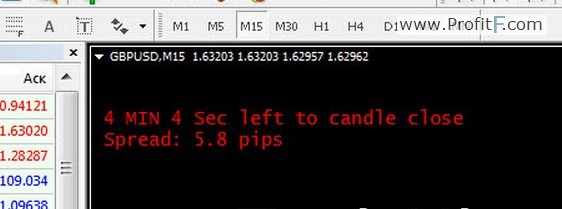
Candle Time Indicator
Drevo dinastiya romanovih. An hourly candlestick shown with depth on a currency exchange. A candlestick chart (also called Japanese candlestick chart) is a style of financial chart used to describe price movements of a,,. Each 'candlestick' typically shows one day, thus a one-month chart may show the 20 trading days as 20 'candlesticks'. Shorter intervals than one day are common on computer charts, longer are possible.
Here you'll find indicators that shows Time Remaining until candlestick closes. These INFO forex indicator that you can use with your own Strategy. This forex indicator is called the MT4 Candle Time Indicator and it is very useful if you want to know how much candlestick time is remaining in a candlestick. Download link is at the very bottom of this post.
It is like a combination of line-chart and a bar-chart: each bar represents all four important pieces of information for that day: The open, the close, the high and the low. Being densely packed with information, they tend to represent over short periods of time, often a few days or a few. Candlestick charts are most often used in of equity and currency price patterns. They are visually similar to, though box plots show different information. Contents • • • • • • • • History [ ] Candlestick charts are thought to have been developed in the 18th century by, a rice trader of. They were introduced to the Western world by in his book, Japanese Candlestick Charting Techniques.
They are often used today in stock analysis along with other analytical tools such as. In Beyond Candlesticks, Nison says, 'However, based on my research, it is unlikely that Homma used candle charts. As will be seen later, when I discuss the evolution of the candle charts, it was more likely that candle charts were developed in the early part of the Meiji period in Japan (in the late 1800s).' Description [ ] Candlesticks are usually composed of the body (black / white or green / red), and an upper and a lower shadow ().
Tiberian sun firestorm units. N/A This modification is one sided but it has a couple new units and buildings.
The area between the open and the close is called the real body, price excursions above and below the real body are shadows. The wick illustrates the highest and lowest traded prices of an asset during the time interval represented.
The body illustrates the opening and closing trades. If the asset closed higher than it opened, the body is hollow or unfilled, with the opening price at the bottom of the body and the closing price at the top.

If the asset closed lower than it opened, the body is solid or filled, with the opening price at the top and the closing price at the bottom. A black (or red) candle represents a price action with a lower closing price than the prior candle's close. A white (or green) candle represents a higher closing price than the prior candle's close.
Thus, the color of the candle represents the price movement relative to the prior period's close and the 'fill' (solid or hollow) of the candle represents the price direction of the period in isolation (solid for a higher open and lower close; hollow for a lower open and a higher close). A candlestick need not have either a body or a wick. Further information: In addition to the rather simple patterns depicted in the section above, there are more complex and difficult patterns which have been identified since the charting method's inception. Complex patterns can be colored or highlighted for better visualization. Rather than using the open-high-low-close for a given time period (for example, 5 minute, 1 hour, 1 day, 1 month, 1 year), candlesticks can also be constructed using the open-high-low-close of a specified volume range (for example, 1,000; 100,000; 1 million shares per candlestick). Generally, the longer the body of the candle, the more intense the trading.